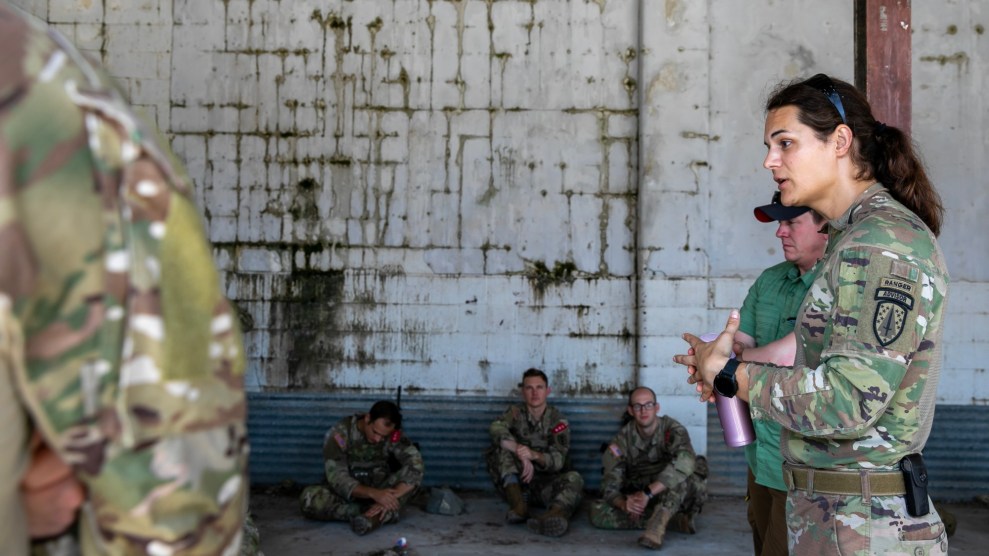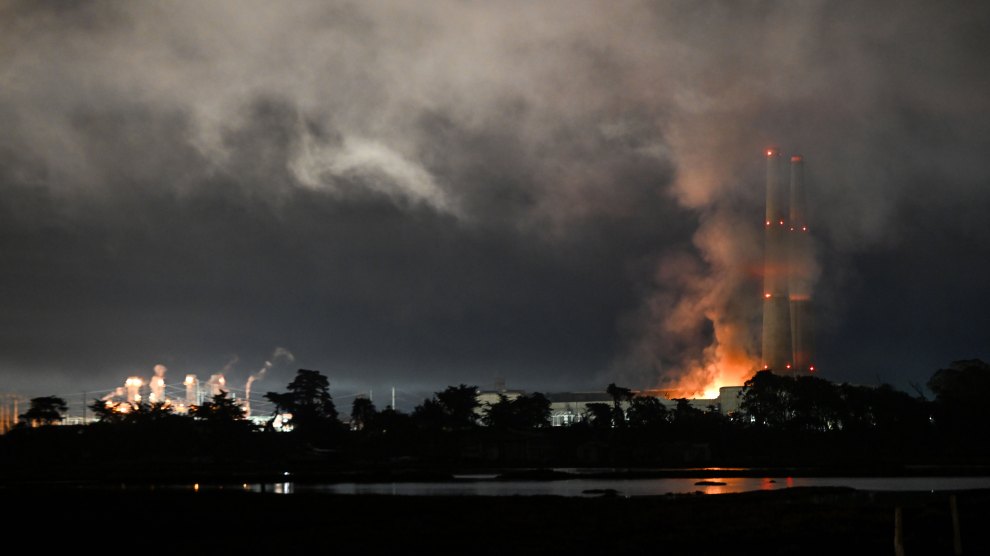Mother Jones: There’s seems to be a growing consensus that March/April 2008 will be some sort of end point for the surge. There’s some debate about how many troops will remain in an interim period. What do you think about that? In terms of the functions that the U.S. would want to continue to perform in a post-surge period—say a year from now—what kind of troop level would the U.S. be talking about?
James Miler: The most likely scenario is that the administration begins to reduce forces in April, and they do so because they don’t want to pay the political price of calling up guardians that have already been called up or extending rotations of the active duty beyond 15 months to 18 months. And so they’ll begin to gradually take brigades out of service and selectively replace those, but it will take us down to something in the range of 110,000 by the end of the Bush administration. I think that’s most likely. What will be missed if they do that is that they will not have developed the adviser capacity to assist in a transition, so as brigades pull out of certain areas, in the places where they’re not replaced, they’ll have to choose between spreading them thinner, which we’ve already tried, and choosing where to have the emphasis, which is probably a more likely choice. But we won’t be prepared to embed American advisers in sufficient numbers with Iraqi units because there’s no way to do both the full replacement that they have planned and to insert advisers. The senior people in those brigades and battalions and companies are the same people that you need to train up to be advisers.
MJ: So you think that we’d want to change the function of the remaining troops to more of a training mission?
JM: That’s right. Whether you think transitioning after the surge succeeded, or if you’re transitioning because you think it’s failed, either way, almost everybody who’s thought about this would want to have U.S. advisers serve for at least a period of time. People who just want to get out quickly and redeploy out of the region and let the Iraqis sort it out themselves are different. But those who still hope that the violence can be contained significantly and see that taking a period of time of U.S. involvement, many of those folks would want to do a transition that involves U.S. advisers.
MJ: What’s the number of American trainers you think you need?
JM: Our rough estimate was 20,000. That was the high end of the Iraq Study Group. Including both military trainers and the police trainers, it’s about 6,000 now. And it’s both quantity and quality. Initially, many of the people who were put into the advisory mission were people who were not ready for command. Now I think you’re getting more of a cross section. If you want this to work, you’re going to have to have not just your average people, but your best people, and you’re going to have to take the time and spend the resources to train them up, and we’re nowhere near being able to do that today.
MJ: Are people starting to listen to these suggestions?
JM: I think there are two different views in the administration. One is basically stay the course, and keep the surge going as long as possible, and it’s only had a very short time since it’s been fully in place, and how could you possibly begin to reduce it at this point, particularly under political pressure?
MJ: Is this the view inside the administration?
JM: I think this is the view among some people inside the administration. And then there’s a view—and I think it’s significant within the administration but I don’t know whether it’s adequate to carry the day—that says, “Look, whatever the status is of the success of the surge, we know we’re going to have to end it in April, and we better start thinking about how we end it and what that process is.” I think there are a number of people who understand that the transition from President Bush to his successor is going to be critical. Actually, I think all of them understand that, and frankly I think there’s a community that would like to make it look as good as possible. That means higher troop levels and keep the story going that everything’s going well. And then there’s a group that would like to have it be as good as possible. And to me, that’s the group that is thinking about the transition and building up an advisory capacity. But I think the fundamental question that’s taken up even at a level higher is, do people think that victory with a capital “V” is possible in Iraq? Or do they just act like it? [I believe] Al Qaeda’s not going to be absolutely gone at the end of this administration; the insurgency is not going to be absolutely gone.
MJ: What do you think of the assumption that the danger of the “maximalist” position is partly that it will lead to a precipitous withdrawal when a new administration comes in, because the American public will be so frustrated?
JM: There are two parts to it. One is that it will affect who gets nominated and elected, and that argument is probably right. The second is that it will encourage in particular Democrats, but it’s possible that it will affect Republicans as well, to take positions that are hard to back down from once they’re elected. I feel like many of the candidates, particularly on the Democratic side, have been very carefully choosing their words and using slightly different words for different audiences. The idea that we need to start the reduction now and start the withdrawal now is popular, and they tend not to say to the far left that by the way, this whole withdrawal might take years.
MJ: Al Qaeda is regrouping in Pakistan. Al Qaeda in Iraq is now a reality. What do you all do with that?
JM: Depending on whose numbers you use, you’ve got an Al Qaeda presence in 60-80 countries across the world. What that means is different in each of those countries—in some cases, very different between the countries, and in some cases, within them. My own cut is that the core Al Qaeda is almost certainly largely centered around Waziristan. That is the single most dangerous group. But the others have such sufficient momentum and resources that you still need to have local efforts—counterterrorism, counterinsurgency efforts—to deal with them.
MJ: Leftist bloggers think that the U.S. presence in Iraq helps Al Qaeda.
JM: It does.
MJ: But doesn’t our leaving embolden them?
JM: Yeah, we’re in a damned if you do, damned if you don’t position right now. And the best we can do is to try to reduce that. In fact, one of the reasons for our recommendation for setting a timeline for withdrawal—and while discussing it with the Iraqis making it clear that it’s on our mutual terms, not on Al Qaeda’s terms—is to begin to work against that narrative.
MJ: So we can advertise it however we want, right? We can say we’re not responding to death numbers going up.
JM: But however you advertise it, Al Qaeda’s going to do their thing.
MJ: Could you coerce Pakistan to be more aggressive as you reduce troops in Iraq?
JM: We absolutely need to do that. I also think that while we can’t completely control the narrative, we can affect it. If you want to talk about withdrawal options—if the option that you went for was precipitous and rapid, to the world that will look like a retreat from utter defeat. If we go out on our own terms, we are more likely to leave something that is not going to totally unwind.
MJ: Do you have any thoughts on the nitty-gritty issues?
JM: If I could start with the more operational level or even strategic level, as you talk to people about it, I would encourage you to make sure you’re clear about [several] questions: One is, what’s the starting point? If withdrawing from 160,000 with forces distributed all over, or widely across, the country is very different from withdrawing from a base with 60,000 where we might be in a year and a half or two years. And second, what are the conditions in Iraq? Withdrawing roughly with the conditions we have today versus an all-out civil war, those are different, and so I think more or less from a planner perspective, you can think of two scenarios. One is significant conflict, and the other is chaos. Don’t bother to develop a plan that assumes peace has broken out in Iraq.
MJ: What do you think about the U.S. trying to help move Iraq toward a soft partition?
JM: I think we’re already doing it. I think if we tried to impose it, then it would be untenable, but given that you’ve still got 90 thousand per month leaving, becoming IDPs or refugees, that’s a lot lower than it was earlier in the conflict, and I heard a number that I haven’t gotten confirmed that said it was down to 60,000 per month. Basically what you’re talking about is moving people from mixed areas into more homogeneous areas, or them moving themselves, and I think the U.S. should help them move safely. When the surge ends in April, there’s two things you can do. You can just let the forces go down and not have a strategy, which is the default, or you can try to have a strategy and fully resource it. My argument is, let’s go to a strategy that requires a lesser amount of resources, but let’s fully resource it.















